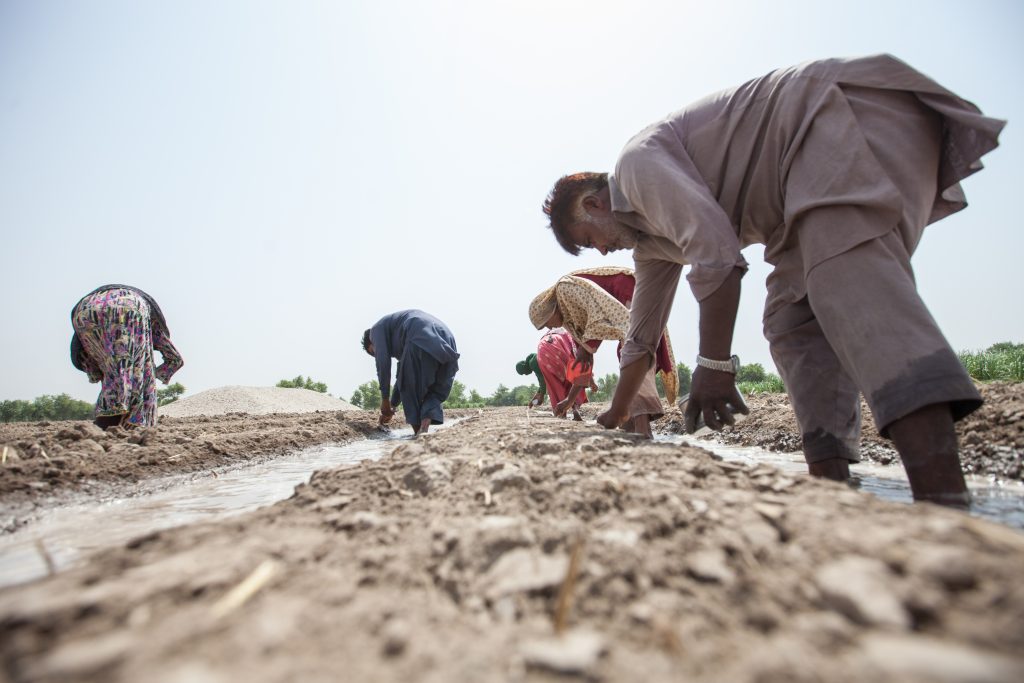


Dr Muhammad Asim Yasin is an agricultural and environmental economist who directly supported Better Cotton Pakistan’s mission through work at the Lok Sanjh Foundation – an Implementing Partner of ours – for more than a decade before turning to academia.
He now serves as an Associate Professor of Economics at COMSATS University Islamabad, Vehari Campus where his experience at the farm level remains a constant source of inspiration.
In 2022, Dr Asim Yasin published a research paper that specifically looked at the impact of Better Cotton’s approach to addressing human exposure to pesticides and the related healthcare costs. The study was a direct comparison between 225 Better Cotton licensed farms and 225 conventional cotton-growing farms. We spoke with Dr Asim Yasin to learn more about his interest, methodology and results.
Tell us about your vocation and the topics you’re passionate about.
I am always interested in topics, programmes and initiatives that contribute to sustainability across agriculture and the environment. Agriculture and the environment are both complex and inextricably linked as the former has an effect on the environment, while climatic changes are impacting the agricultural industry.
What sparked your interest in Better Cotton and the focus of this particular paper – pesticides and their impact on human health?
I became familiar with Better Cotton back in 2014 while working for Lok Sanjh Foundation – an Implementing Partner of Better Cotton. We trained farmers to grow cotton in line with the Better Cotton Standard System. During field visits, I saw farmers follow Better Cotton’s Principles & Criteria, which sparked my interest in initiating research on different aspects of Better Cotton production.
Cotton is considered the dirtiest crop in the world as far as pesticide consumption is concerned. In Pakistan, farmers usually hire pesticide applicators to apply pesticides in the cotton fields, bringing them in direct contact with pesticides, thus causing different types of hazards. Better Cotton trains pesticide applicators and farmers to use pesticides safely. So, the focus of this particular study was to compare pesticide exposure and healthcare costs among pesticide applicators working on both Better Cotton and conventional cotton farms.
Can you summarise your approach to this study and the time over which you conducted it?
Intensive pesticide use can severely affect both the social and economic benefits of cotton production, as the overuse of inputs can impact human health as well as the cost of formulations. According to Better Cotton’s Principles & Criteria, pesticide application is the last option to manage pests. So, the main purpose of my research was to assess the importance of Better Cotton’s approach as a means to lessen the health effects of pesticide exposure. The study was carried out during the 2020/21 cotton season across three districts of Punjab – Toba Tek Singh, Bahawalnagar and Layyah. Although pesticide residues affect all farmers and farm workers, this study exclusively focused on pesticide applicators directly exposed to pesticides. The respondents were selected from a list provided by the Lok Sanjh Foundation. It took almost a year to complete the study including initial meetings, survey, data collection, data mining, analysis and write up.
What were the key areas of distinction between Better Cotton licensed farmers and conventional cotton-producing farmers in terms of the results you obtained?
Generally, both groups used almost the same pesticides that were available in the local market. The results showed that 47% of the pesticide applicators working on Better Cotton licensed farms were not affected compared to 22% of those on conventional cotton-producing farms. This was mainly due to the adoption of safety equipment by applicators on Better Cotton-producing farms. Regarding the uptake among respondents, on average, 88% wore boots on Better Cotton licensed farms compared to 63% on farms producing conventional cotton. On Better Cotton licensed farms, 52% used handkerchiefs (compared to 25%), 57% wore glasses (compared to 22%), 44% wore gloves (compared to 25%), and 78% wore masks (compared to 47%). Results showed that conventional cotton pesticide applicators experienced a greater, negative impact on their health when compared to pesticide applicators on Better Cotton licensed farms.
What’s more, on average, conventional cotton pesticide applicators faced a higher healthcare cost over the period we assessed compared to applicators on Better Cotton licensed farms, due to negligence in the use of precautionary measures.
What are the key challenges and barriers facing Pakistani cotton farming communities in relation to the adoption of more sustainable pesticide solutions and use of appropriate practices and equipment?
A lack of education along with limited access to the government’s agricultural support services, and to sustainable agriculture programmes like Better Cotton are the key factors resulting in lower adoption of best agricultural practices. In this study, alignment with the Better Cotton Standard System and education on safe and effective pesticide application were significant factors that reduced the financial toll on pesticide applicators. The role of extension services is important to educate farmers and farm workers on pesticide use. More investment on education of rural communities could help pesticide applicators better understand the associated risks and enable them to adopt proper precautionary measures against exposure.
How confident are you that systemic change will be achieved on this topic in order to protect cotton farming communities and, in your opinion, what levers must be used to enable this?
Change is not a one-day process, it takes time. The results of different research studies conducted on Better Cotton are quite encouraging in showing that systemic change will be achieved in the near future. We need to expand programmes like Better Cotton to an even bigger scale to involve the maximum number of farmers and conduct research across different sustainability metrics to highlight the scope for impact.
In your opinion, where should future research efforts on cotton in Pakistan be directed?
Following are key areas for research:
- In many areas of central and southern Punjab, which were considered the core areas of cotton production, cotton is replaced by other crops like maize and sugarcane on large tracts of land. Research should be conducted to find out the reasons why, including the climatic, agronomic and economic aspects.
- The scope for more sustainable agricultural practices to improve the cotton value chain.
- The benefits of adopting sustainable practices for cotton picking, storing and transportation and their implications for farmers’ profitability.
- The economic and social impacts of harvest and post-harvest losses.
- The ecological, economic and social challenges associated with transitioning to the production of more sustainable cotton and how they can be overcome.
- The need to assess the current geographical distribution and suitability of cotton production in terms of both quality and quantity base in other non-traditional areas.







































